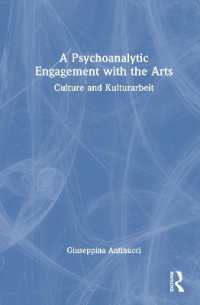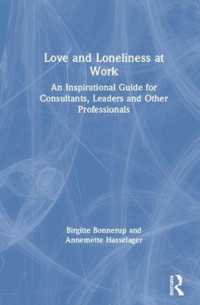- ホーム
- > 洋書
- > 英文書
- > Science / Mathematics
Full Description
When Joseph Murray performed the first successful living kidney donor transplant in 1954, he thought this would be a temporary stopgap. Today, we are no closer to the goal of adequate organ supply without living donors--if anything, the supply-demand ratio is worse. While most research on the ethics of organ transplantation focuses on how to allocate organs as a scarce medical resource, the ethical treatment of organ donors themselves has been relatively neglected. In The Living Organ Donor as Patient: Theory and Practice, Lainie Friedman Ross and J. Richard Thistlethwaite, Jr. argue that living donor organ transplantation can be ethical provided that we treat living solid organ donors as patients in their own right.
Ross and Thistlethwaite develop a five-principle framework to examine some of the attempts to increase living donation. It uses the three principles of the Belmont Report: respect for persons, beneficence, and justice modified to organ transplantation, as well as the principles of vulnerability and special relationships creating special obligations. Their approach requires that the transplant community fully embrace current and prospective living organ donors as patients to whom we have special obligations. Only when living organ donors are regarded as patients in their own right and have a living donor advocate team dedicated to their well-being can the moral limits of living solid organ donation be realized and living donors be given the full respect and care they deserve.
Contents
Part 1: INTRODUCTION
Chapter 1: Introduction
Chapter 2: History of Solid Organ Transplantation
Chapter 3: Developing a Living Donor Ethics Framework
Part 2: DONOR SELECTION DEMOGRAPHICS
Chapter 4: Women and Minorities as Living Organ Donors
Chapter 5: Minors as Living Organ Donors
Chapter 6: Prisoners as Living Organ Donors
Part 3: EXPANDING LIVING DONOR TRANSPLANTATION
Chapter 7: The Good Samaritan or Non-Directed Donor
Chapter 8: Kidney Paired Exchanges and Variants
Chapter 9: Expanding Living Liver Donor Transplantation
Chapter 10: Living Liver Donor Transplantation for Acute Liver Failure
Part 4: MORAL LIMITS TO EXPANDING LIVING DONORS
Chapter 11: The Imminently Dying Donor
Chapter 12: Challenging (Organ and Global) Boundaries
Chapter 13: Organ Markets
Part 5: DECISION-MAKING AND RISK THRESHOLDS
Chapter 14: Candidate Criteria for Living versus Deceased Donor Liver Grafts: Same or Different?
Chapter 15: Dealing with Uncertainty: APOL1 as a Case Study
Chapter 16: Questioning the premise: Is living donor organ transplantation ethical?







